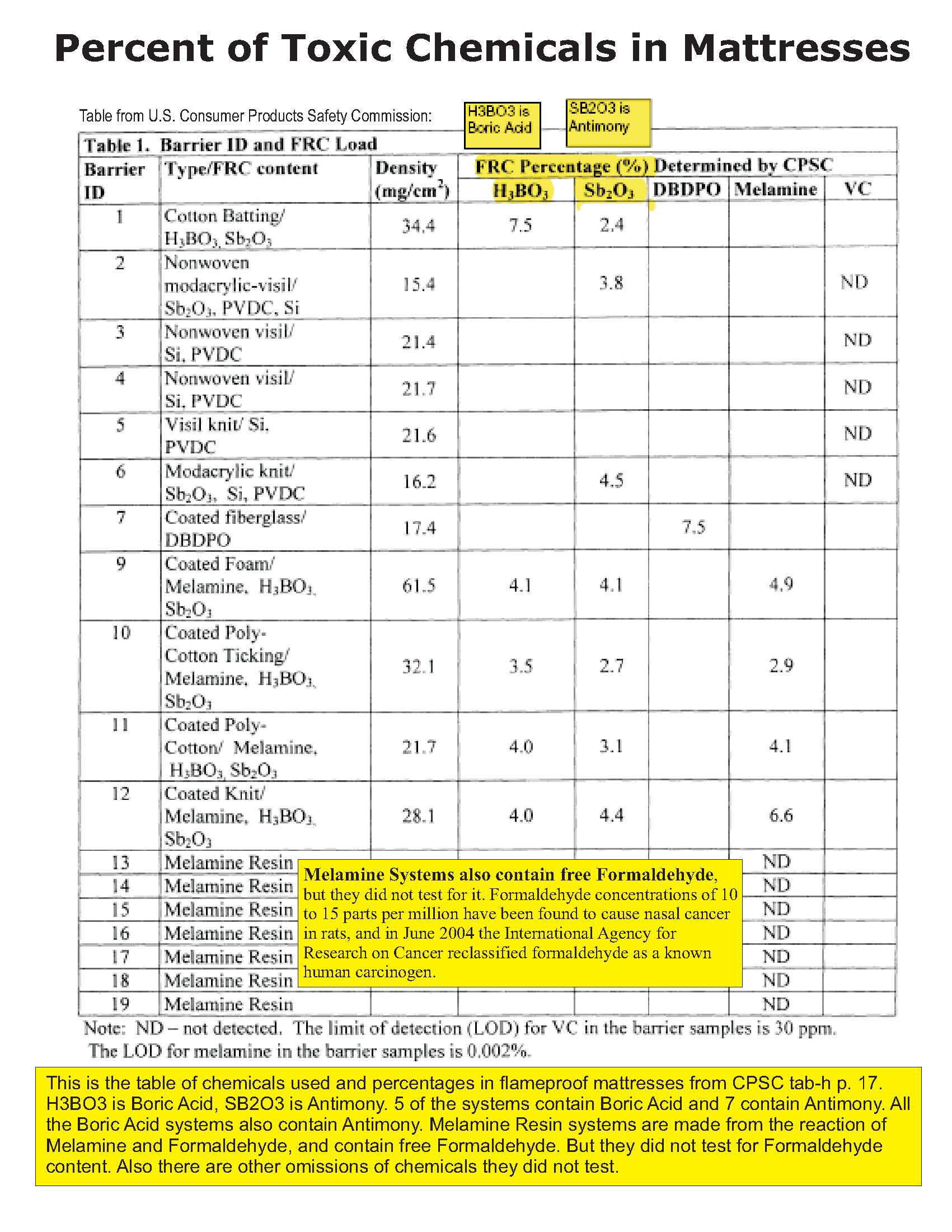
PrescriptionBeds.com
Truly Organic Mattresses Free Bed & Sample Contact Us Tell a Friend
The Consumer Products Safety Commission (CPSC) knows which chemicals are used to flameproof mattresses as presented in their table below:
To help you read the table below: H3BO3 is Boric Acid, SB2O3 is Antimony, DBDOP is Decabromodiphenyl Oxide, also called Deca

Table 1 from Tab H, p
17,
http://www.cpsc.gov/library/foia/foia06/brief/matttabh.pdf
Melamine Resin Barriers are made from the reaction of Melamine (Melamine was recently found in pet food and is known to kill dogs and cats) and Formaldehyde, and contain free Formaldehyde, but these barriers were not tested for Formaldehyde content. Formaldehyde concentrations of 10 to 15 parts per million have been found to cause nasal cancer in rats, and in June 2004 the International Agency for Research on Cancer reclassified formaldehyde as a known human carcinogen.
As you can see above 7 of the barriers contain Antimony and 5 contain Boric Acid. It is no wonder there are no labeling requirements for the FR chemicals used in mattresses. Which of the above systems would you choose to sleep in? We don’t think any of these systems are safe, they all have risks.
Cotton Batting barriers contain 10% poison, 7.5% Boric Acid plus 2.4% Antimony. Melamine Resin barriers contain Formaldehyde. Silicon and Formaldehyde were not studied.
We keep hearing about inherently flame resistant fibers from the CPSC and mattress manufacturers. These inherently flame resistant fibers have chemicals blended with the fiber as the fiber is made. The only true inherently flame resistant fiber is fiberglass, and even that is blended with chemicals to make a barrier as you can see in the table above.
FORMALDEHYDE MSDS: "POISON! DANGER! SUSPECT CANCER HAZARD. MAY CAUSE CANCER. Risk of cancer depends on level and duration of exposure. VAPOR HARMFUL. HARMFUL IF INHALED OR ABSORBED THROUGH SKIN. CAUSES IRRITATION TO SKIN, EYES AND RESPIRATORY TRACT. STRONG SENSITIZER. MAY BE FATAL OR CAUSE BLINDNESS IF SWALLOWED. CANNOT BE MADE NONPOISONOUS." http://www.jtbaker.com/msds/englishhtml/F5522.htm
Si is Silicon, which was not tested for either. It also has health risks: “Silicon may cause chronic respiratory effects. … Inhalation will cause irritation to the lungs and mucus membrane. Several epidemiological studies have reported statistically significant numbers of excess deaths or cases of immunologic disorders and autoimmune diseases in silica-exposed workers. These diseases and disorders include scleroderma, rheumatoid arthritis, systemic lupus erythematosus, and sarcoidosis. Recent epidemiological studies have reported statistically significant associations of occupational exposure to crystalline silica with renal diseases and subclinical renal changes. Crystalline silica may affect the immune system, leading to mycobacterial infections (tuberculous and nontuberculous) or fungal, especially in workers with silicosis Occupational exposure to breathable crystalline silica is associated with bronchitis, chronic obstructive pulmonary disease (COPD) and emphysema. … Lung cancer is associated with occupational exposures to crystalline silica http://www.lenntech.com/Periodic-chart-elements/Si-en.htm#Health%20effects%20of%20silicon
Ammonium Polyphosphate is the only other chemical used to flame proof mattresses not listed above. Not as much is know of how toxic this chemical is to sleep in, but it is doubtful sleeping in and absorbing this fertilizer could be good for us. The CPSC has shown large amounts of this chemical leach from mattresses.
Antimony: Quote from College Chemistry Textbook: “Antimony resembles Arsenic very closely; the difference in its behavior being almost entirely accounted for by the fact that antimony is slightly more metallic.” This helps explain why it is so poisonous. Quotes from ATSDR a division of the CDC on Antimony: “An increase in the number of spontaneous abortions, disturbances in menstruation, failure to conceive, May cause heart to beat irregularly or stop. … Chronic Exposure: Prolonged or repeated exposure may damage the liver and the heart muscle." “In long-term studies, animals that breathed very low levels of antimony had eye irritation, hair loss, lung damage, and heart problems. Problems with fertility were also noted.” "Two studies reported lung tumors in rats exposed to relatively low levels of antimony trioxide." Antimony tends to accumulate in the liver and gastrointestinal tract.” The CDC cannot determine a safe level of Antimony exposure because: “At the lowest exposure levels tested, the adversity of the effects was considered to be serious.” On cancer risks of Antimony even the CPSC admits: “The cancer effects are cumulative. Every exposure contributes to the overall lifetime risk of developing cancer.”
Boric Acid, also known as the best Roach Killer, is a known reproductive and developmental toxin, a known respiratory irritant, Demonstrated injury to the gonads and to the developing fetus. high prenatal mortality, Neonatal children are unusually susceptible. There are already 6,463 U.S. cases of Boric Acid poisoning each year. One human exposure study showed reduced sperm counts and reduced sexual activity in humans. Fatal human single dose reported at: 2g Child, 5g Adult.
DBDPO, Deca, is in the family of PBDE’s being found in women’s breast milk, is known to bioaccumulate, is linked to cancer, and groups are trying to get it banned.
Do you want to sleep in these chemicals? Or would you rather take the one in one million risk of dying in a mattress fire? Ask your Doctor for a Prescription for a clean bed.